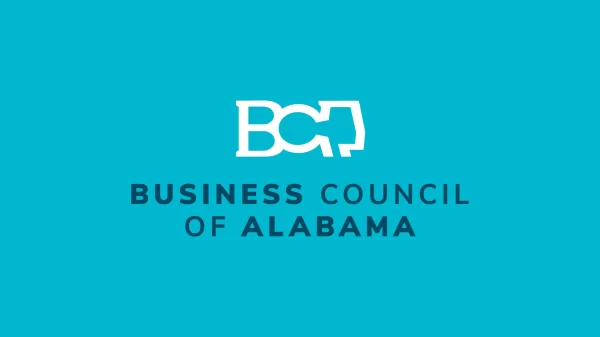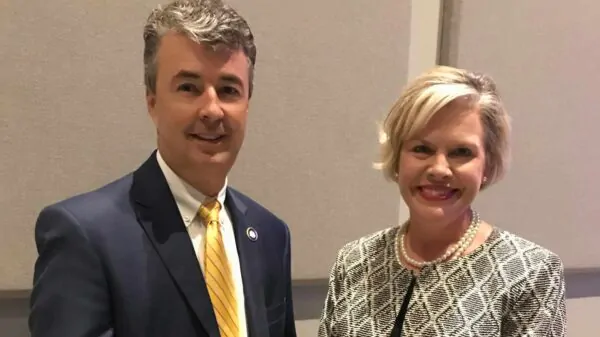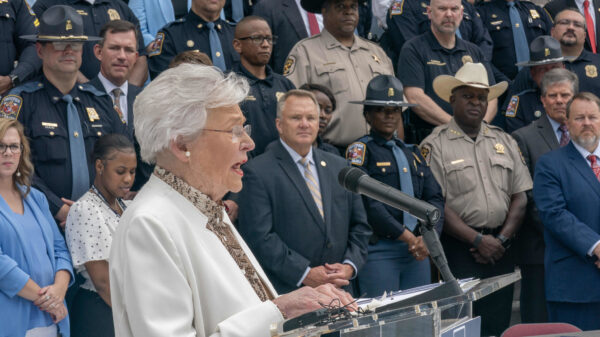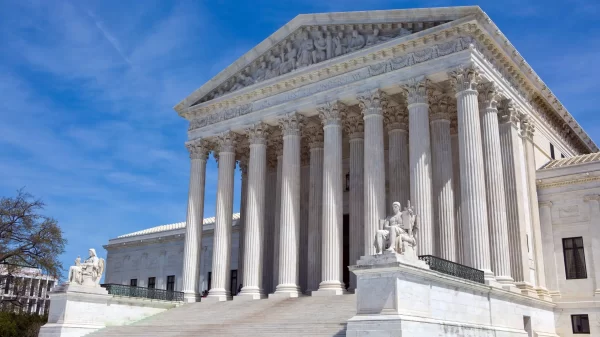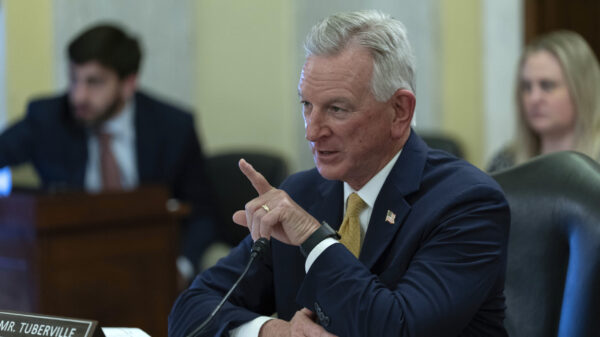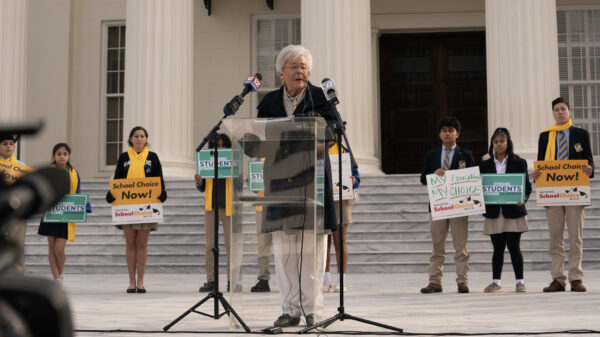On Friday, the White House released its proposed discretionary budget for the federal government’s 2026 fiscal year. While discretionary spending only accounts for just over a quarter of all federal spending, the president’s budget would still represent a significant embrace of public austerity if adopted by Congress.
The proposal would reduce total discretionary spending by almost $140 billion, or 7.6 percent, by drastically cutting and reorganizing many major programs and eliminating several smaller agencies. Meanwhile, the Department of Defense and Department of Homeland Security would both see significant budget increases of over $100 billion and over $40 billion, or 13.4 and 64.9 percent, respectively.
Russell Vought, the director of the U.S. Office of Management and Budget and a contributor to the Heritage Foundation’s Project 2025 document, wrote in a letter to the chair of the Senate Committee on Appropriations that the proposal is the result of “a rigorous, line-by-line review of FY 2025 spending.”
Consistent with past messaging from the second Trump administration, Vought said the budget has been “laden with spending contrary to the needs of ordinary working Americans and tilted toward funding niche non-governmental organizations and institutions of higher education committed to radical gender and climate ideologies antithetical to the American way of life.”
Many descriptions of the proposed changes suggest state governments like Alabama’s ought to pick up the bill for defunded or eliminated programs. Various reasons given include that cut programs would “be best funded by States,” eliminating certain agencies will “promote federalism,” and that select funding sources “have become a crutch for States at the expense of taxpayers.”
The list below attempts to summarize some of the most significant proposed cuts for Alabama residents, including context about how different programs have benefited the state in recent years.
Department of Education: -$12 billion (15.3 percent)
Federal funding for charter schools would increase by $60 million or 13 percent under the proposed budget, while many programs meant to support public schools and help people attend college would be attenuated or fully terminated.
A new “K-12 Simplified Funding Program” would replace 18 grant programs currently run by the department with one $2 billion formula grant program. The Department of Education has not publicly clarified which 18 programs would be replaced, and an inquiry from APR has gone unanswered, but the proposal places the total decrease in spending at $4.5 billion.
TRIO and GEAR UP, programs meant to help low-income and first-generation students attend college, are both marked for termination. Federal work-study, a program that pays up to 75 percent of the wages for student workers who need a job to pay their expenses, would be “return[ed] to the States and IHEs that financially benefit from it.”
Adult education programs, English language acquisition programs, and supplemental educational opportunity grants would also be targeted for elimination.
The National Center for Education Statistics records that Alabama received $1.9 billion for its public education system from federal programs in the 2022 fiscal year. GEAR UP Alabama says that it helped “nearly 9,300 students” between 2014 and 2021, while GEAR UP Achieve, an Auburn University program, reports its total cohort is 6,500 students.
Department of Health and Human Services: -$33.3 billion (26.2 percent)
APR reported in March that HHS had already unilaterally cut hundreds of millions in grants for various Alabama public health programs and research projects. In addition to formalizing many of these cuts, the president’s budget proposal would end the Low Income Home Energy Assistance Program, or LIHEAP, Community Services Block Grants, and shutter several CDC research centers.
Data from an HHS website shows that in the last fiscal year, LIHEAP helped 70,818 Alabama households pay for heating and 47,578 households pay for cooling.
LIHEAP beneficiaries have to earn less than 150 percent of the federal poverty level in order to receive between $320 and $520 a year to pay for cooling and $280 and $580 a year to pay for heating if needed. The Trump administration laid off all of the federal workers working to keep LIHEAP running in April.
“We just found out like a week ago that this year’s money got released,” Alabama Arise Senior Policy Analyst Carol Gundlach told APR. “Everybody was really worried that the DOGE people had laid off the entire LIHEAP staff in Washington D.C. so nobody was really sure until this week whether or not there was gonna be LIHEAP money for cooling for this summer.”
Gundlach explained that the program is vital because without it, “people in Alabama who are disproportionately elderly, disproportionately disabled, disproportionately people who need electricity to do things like run breathing machines are gonna be at very high risk of being cut off. And also losing your electricity means you lose your housing, too, because that’s often a condition of keeping your housing.”
According to an application uploaded by the Alabama Department of Economic and Community Affairs, Alabama is planning on receiving over $26 million in community services block grants for the 2025 and 2026 fiscal years, which would be divided among community action programs across the state.
One of these community action programs, Community Action of Etowah County, runs home gardening and budget counseling programs in addition to the standard home weatherization, rental assistance, and LIHEAP initiatives. All of them are subject to regular reviews and audits.
Environmental Protection Agency: -$5.0 billion (54.5 percent)
The budget proposal would cut an annual appropriation of $2.4 billion for states’ clean and drinking water revolving loan funds. Revolving loan funds allow states to continually offer cheap financing for improvements to local infrastructure by lending out money and then lending it out again once the initial loan recipient pays it back.
According to the latest audits for Alabama’s DWSRF and CWSRF, the two funds combined have over $1.3 billion in total assets and lent out over $120 million last year for projects across the state at between 1 and 1.5 percentage points below prevailing market rates.
The EPA would also have $1 billion in appropriations for categorical grants cut. Alabama has received tens of millions of dollars in grants from the EPA in recent years.
Department of Commerce: -$1.7 billion (16.5 percent)
The Trump White House has proposed fully eliminating the Economic Development Administration and the Minority Business Development Agency.
The EDA’s most recent annual report from 2023 records that the agency funded over a dozen programs in Alabama that year, from assistance for the Mobile Airport Authority to public works funding for Phenix. EDA funding for Alabama totaled over $20 million. Including matching funds, the EDA helped provide over $33 million in funding for various projects in the state.
A roughly 25 percent cut to the National Oceanic and Atmospheric Administration, purportedly targeted at research funding that would advance “a radical climate agenda” and “Green New Deal” initiatives, could also have consequences for NOAA’s core competencies, namely its abilities to help predict the weather and track hurricanes.
Department of Housing and Urban Development: -$33.6 billion (43.6 percent)
“The president’s budget is proposing drastically cutting and essentially block granting housing assistance, which means everybody who is living in subsidized housing. That includes, again, elderly people in what’s called 202 housing,” Gundlach explained. “People who are living in subsidized rental housing, they’re at real risk of losing their housing.”
“I am real worried if the budget goes through the way it’s written, we’ll see an epidemic of homelessness in Alabama and all over the country,” she stated.
The budget proposal would cut funding for rental assistance, public housing, and housing for the elderly and disabled by 43 percent, replacing it with a block grant program that would supposedly “encourage States to provide funding to share in the responsibility.”
Other initiatives like the HOME Investment Partnerships Program, which helps finance affordable rental housing, and community development block grants would be cut entirely.
According to publicly available data from HUD, over 33,000 Alabama families currently receive housing choice vouchers and there are over 26,000 leased units in public housing developments across the state.
Department of the Interior: -$5.1 billion (30.5 percent)
Under the president’s budget proposal, the National Park Service would see a more than $1 billion budget cut, in part accomplished by attempting to transfer responsibility for “a large number of sites that are not ‘National Parks’ in the traditionally understood sense” to the states.
While it’s unclear which sites are being referred to, the National Park Service helps manage a dozen different sites in the state of Alabama, including the Selma to Montgomery Historic Trail, the Montgomery Bus Station, and the Freedom Riders Museum. APR reported earlier this year that the General Services Administration, likely under the direction of DOGE, had marked the Montgomery Bus Station and Freedom Riders Museum as up for sale, although this was eventually walked back.
Conservation and renewable energy programs would also be significantly diminished in scale or ended.
Department of Agriculture: -$5.0 billion (18.3 percent)
In addition to eliminating funding for allegedly “woke” programming and research, the budget proposal for the Department of Agriculture would also slash funding for rural development, forest management, and state conservation programs.
Rural development programs singled out as on the chopping block in the budget proposal includes any new USDA funding for broadband expansion, “rural business programs, single family housing direct loans, self-help housing grants, telecommunications loans, and rural housing vouchers.” Expanding rural broadband access has been a major goal of ADECA in recent years, as the agency has been issuing hundreds of millions in federal funds as grants to projects across the state.
The Commodity Supplemental Food Program, which provides free, nutritious food to American seniors, would be replaced by a system of “MAHA food boxes” under the proposal. Over 9,000 Alabama residents participate in the CSFP every year.
NASA: -$6.0 billion (24.3 percent)
The proposed NASA budget would increase funding for human space exploration, but it would dramatically decrease funding for research projects. The proposal also calls to begin retiring the Space Launch System rocket, Orion capsule, and International Space Station in favor of unspecified commercial alternatives. This shift appears likely to significantly benefit Trump ally Elon Musk, who owns 42 percent of private rocketry company SpaceX.
The Marshall Space Flight Center in Huntsville has been key in the development of the SLS and employs over 7,000 people. And one document produced by NASA in 2023 estimates that the agency supports over 40,000 jobs in Alabama and spent $2.7 billion in Alabama in the 2021 fiscal year.
That report also suggests NASA’s total economic effect on Alabama resulted in $235 million in tax revenue for the state.
Alabama Senator Katie Britt has defended the Space Launch System and NASA’s role in Alabama in the past, telling Alabama Daily News in February that “our past achievements and future ambitions prove Alabamians will continue to play an integral role.” Her office did not respond to a request for comment from APR regarding the recently proposed cuts.
National Science Foundation: -$4.9 billion (55.8 percent)
The Trump administration’s budget would cut funding for “climate; clean energy; woke social, behavioral, and economic sciences; and programs in low priority areas of science.”
In addition to the significant second-order benefits of public research funding, Alabama’s many institutes of higher education rely heavily on federal research grants. The University of Alabama at Huntsville alone received over $150 million in federal funding for various research and development projects in the last fiscal year.
University of Alabama political science professor Nick Davis told APR in January that the Trump administration’s indefinite pause on NSF grants, which at the time included grants for research on promising cancer treatments, “literally threatens Americans lives” in addition to needlessly threatening academics’ careers.
Small Agencies: -$3.6 billion (23 agencies or programs)
More than 20 smaller agencies were marked for termination in the president’s budget proposal, including AmeriCorps.
The “federal agency for national service and volunteerism,” the precursor to AmeriCorps was established in 1965. At the time, President Johnson described it as “an opportunity to work here at home in constructive ways as volunteers, going to war against poverty instead of going to war against foreign enemies.” Today the typical AmeriCorps member receives a living allowance of $4,800 for a year of work helping America’s poorest communities.
A search of the AmeriCorps website reveals over a dozen programs in Alabama currently accepting applications. These opportunities included helping expand the Bundles of Hope Diaper Bank, updating databases for a religious organization that builds homes and hosts day camps/after-school ministry programs, and coordinating public health outreach programs in the Birmingham area.
AmeriCorps also works with state governments, including the Alabama Governor’s Office of Volunteer Services, to help cover the operating costs of independent volunteer programs. In the 2025-2026 window, Alabama-based programs, including local branches of Teach for America and Goodwill, were given over $1.5 million in grants.
The New York Times reported last week that hundreds of millions of dollars in these grants issued through AmeriCorps, including all funding for Alabama, have already been terminated by the Trump administration, leaving individuals and organizations who had been working to improve their country worried about what will happen next.
One incoming Teach for America participant told APR that it’s her “understanding that TFA is going to attempt to find ways to continue to support Corps Members, but we don’t know yet what form this support will take.” Normally AmeriCorps helps finance TFA participants’ educations, including the master’s degrees required for Class A teaching certifications in the state of Alabama.
“Corps Members really do want to do the work to support these kids – we just want the federal government to support this work,” she explained. “I believe that one day, every child can have access to a high-quality education, regardless of what neighborhood they live in, and that ‘one day’ is most possible when our nation steps up and protects the programs, like TFA, that are supporting every child.”
Another one of the agencies singled out for termination is the Southeast Crescent Regional Commission, a product of the bipartisan 2008 farm bill that was reauthorized by another bipartisan bill in 2024. The commission oversees several grant programs meant to encourage economic development in the southeast.
The SCRC’s 2024 annual report states that they invested $1.04 million in Alabama, spurring an additional $2.21 million in matching funds and creating almost 900 jobs in the state.
In past press releases from as recently as July and October, Governor Kay Ivey and ADECA Director Kenneth Boswell repeatedly praised the SCRC and its impact on Alabama’s infrastructure and economy.
The White House’s budget proposal claims “states and local governments are better positioned to fund” the projects the commission had focused on. ADECA has not responded to APR’s request for comment.



